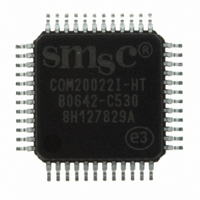COM20022I-HT SMSC, COM20022I-HT Datasheet - Page 24

COM20022I-HT
Manufacturer Part Number
COM20022I-HT
Description
IC CTRLR ARCNET 2KX8 RAM 48-TQFP
Manufacturer
SMSC
Series
ARCNETr
Datasheet
1.COM20022I3V-HT.pdf
(82 pages)
Specifications of COM20022I-HT
Controller Type
ARCNET Controller
Interface
Differential
Voltage - Supply
4.5 V ~ 5.5 V
Current - Supply
65mA
Operating Temperature
-40°C ~ 85°C
Mounting Type
Surface Mount
Package / Case
48-TQFP, 48-VQFP
Lead Free Status / RoHS Status
Lead free / RoHS Compliant
Other names
638-1003
Available stocks
Company
Part Number
Manufacturer
Quantity
Price
Company:
Part Number:
COM20022I-HT
Manufacturer:
Standard
Quantity:
5 410
Company:
Part Number:
COM20022I-HT
Manufacturer:
SMSC
Quantity:
455
Company:
Part Number:
COM20022I-HT
Manufacturer:
Microchip Technology
Quantity:
10 000
5.1.4
5.1.5
5.1.6
Revision 09-27-07
The following sequences show the data transfer for a DMA read and a DMA write. The transfer of data
between system memory and internal RAM functions as a memory to I/O DMA transfer. Since it is treated
as an I/O device, the COM20022I has to create the RAM address. Therefore the COM20022I’s address
pointers must be programmed before starting the DMA transfers.
DMA Data Transfer Sequence (I/O to Memory: Read A Packet)
step1: Set DMA-controller (ex. 8237)
step2: Set DRQPOL, TCPOL, DMAMD1 and DMAMD0 bits
step3: Set address, byte count and etc. of DMA controller
step4: Set pointer High and Low (RDDATA=1,AUTOINC=1, DMAEN=0)
step5: Read SID, DID, CP in the received packet
step6: Set DMAEN=1 (RDDATA=1, AUTOINC=1)
step7: DMAEND=1 in Mask REG.
step8: Set pointer = CP
DMA Data Transfer Sequence (Memory to I/O: Write A Packet)
step1: Set DMA-controller (ex. 8237)
step2: Set DRQPOL, TCPOL, DMAMD1 and DMAMD0 bits
step3: Set address, byte count and etc. of DMA controller
step4: Set pointer High and Low (RDDATA=0,AUTOINC=1, DMAEN = 0)
step5: Write SID,DID,CP in the sending packet
step6: Set DMAEN=1 (RDDATA=0, AUTOINC=1)
step7: DMAEND=1 in Mask REG.
step8: Set pointer = CP
step9: Write Enable Transmit command to command register
High Speed CPU Bus Timing Support
High speed CPU bus support was added to the COM20022I. The reasoning behind this is as follows: With
the Host interface in Non-multiplexed Bus mode, I/O address and Chip Select signals must be stable
before the read signal is active and remain after the read signal is inactive. But the High Speed CPU bus
timing doesn't adhere to these timings. For example, a RISC type single chip microcontroller (like the
HITACHI SH-1 series) changes I/O address at the same time as the read signal. Therefore, several
external logic ICs would be required to connect to this microcontroller.
In addition, the Diagnostic Status (DIAG) register is cleared automatically by reading itself. The internal
DIAG register read signal is generated by decoding the Address (A2-A0), Chip Select (nCS) and Read
(nRD) signals. The decoder will generate a noise spike at the above tight timing. The DIAG register is
cleared by the spike signal without reading itself. This is unexpected operation. Reading the internal RAM
and Next Id Register have the same mechanism as reading the DIAG register.
Therefore, the address decode and host interface mode blocks were modified to fit the above CPU
interface to support high speed CPU bus timing. In Intel CPU mode (nRD, nWR mode), 3 bit I/O address
(A2-A0) and Chip Select (nCS) are sampled internally by Flip-Flops on the falling edge of the internal
delayed nRD signal. The internal real read signal is the more delayed nRD signal. But the rising edge of
nRD doesn't delay. By this modification, the internal real address and Chip Select are stable while the
internal real read signal is active. Refer to Figure 5.7 on the following page.
>>Finished DMA SETUP
>>A packet received
>>DREQ is asserted by step8
>>Interrupt occurs upon finishing DMA
>>Finished DMA SETUP
>>DREQ is asserted by step8
>>Interrupt occurs upon finishing DMA transfer
DATASHEET
Page 24
10 Mbps ARCNET (ANSI 878.1) Controller with 2Kx8 On-Chip RAM
SMSC COM20022I
Datasheet













